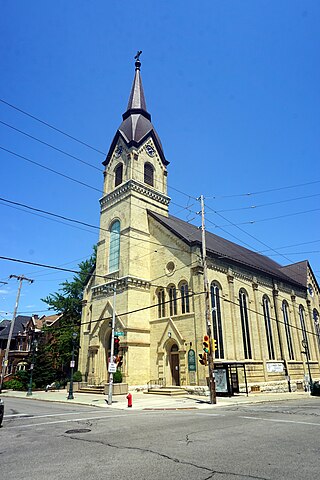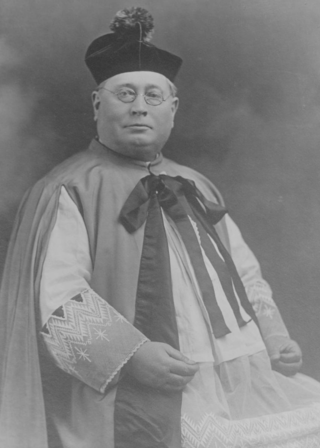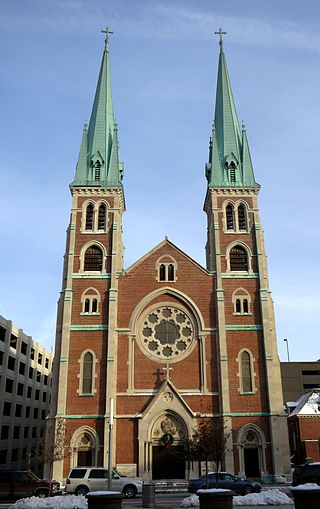
The Basilica of Saint Louis, King of France, formerly the Cathedral of Saint Louis, and colloquially the Old Cathedral, is a Catholic church in St. Louis, Missouri. It was the first cathedral west of the Mississippi River and until 1844 the only parish church in St. Louis. It is one of two Catholic basilicas in St. Louis and both are named for King Louis IX of France.

The Cathedral of St. John the Evangelist is the episcopal see of the Catholic Archdiocese of Milwaukee in Milwaukee, Wisconsin. The building itself is in German Renaissance Revival style, built in 1847, with changes after several fires. It is listed on the National Register of Historic Places and designated a Milwaukee Landmark. It is located just east of Cathedral Square Park.

Calvary Cemetery is the oldest existing Catholic cemetery in Milwaukee, Wisconsin. Owned by the Archdiocese of Milwaukee, it is the final resting place for many of the city's early influential figures. The cemetery was designated a Milwaukee Landmark in 1981.
Catholic Charities of the Archdiocese of Chicago is the largest in a nationwide network of faith-based social service providers that form Catholic Charities. Together they form the largest private network of social service providers in the United States. More than 1,400 agencies, institutions, and organizations make up the Catholic Charities network, which provides services to nearly 10 million people in need each year regardless of religious, social, or economic backgrounds. The network also seeks to advocate for issues of importance to those in need.

The Church of St. Vincent Ferrer is a Roman Catholic parish in the Upper East Side of Manhattan, New York City. It was built in 1918 by the Dominicans; the attached priory serves as the headquarters of the Eastern United States Province of the order. Its architecture has some unusual features: above the front entrance is one of the few statues of the Crucifixion on the exterior of an American Catholic church; and inside, the Stations of the Cross depict Christ with oil paintings instead of statuary or carvings. It has two Schantz pipe organs. The church building, at the corner of Lexington Avenue and East 66th Street in the Lenox Hill section of the Upper East Side, has been called "one of New York's greatest architectural adornments."
St. Vincent's may refer to:

Saint Stanislaus Kostka Catholic Church is a historic Polish church of the Roman Catholic Archdiocese of Chicago that is located at 1351 West Evergreen Avenue in the Pulaski Park neighborhood of Chicago, Illinois, United States. It is designated as the Sanctuary of Divine Mercy of the Archdiocese.

St. Hedwig's Roman Catholic Church, is a church and former parish of the Roman Catholic located at 1702 N. Humboldt Ave. on Milwaukee, Wisconsin's East Side at the center of the East Brady Street Historic District, in the Roman Catholic Archdiocese of Milwaukee.

Hyacinth Gulski was a pioneer Polish-American Roman Catholic priest. He served as Archdiocesan Consultor to the Roman Catholic Archdiocese of Milwaukee.

Sister Irene was an American nun who founded the New York Foundling Hospital in 1869, at a time when abandoned infants were routinely sent to almshouses with the sick and insane. The first refuge was in a brownstone on E.12th St. in Manhattan, where babies could be left anonymously in a receiving crib with no questions asked. The practice was an echo of the medieval foundling wheel and an early example of modern "safe haven" practices.

The Healy Asylum is an historic building in Lewiston, Maine. It was built in 1893 as an orphanage for boys, a role it served until about 1970. It is now known as Healy Terrace, and is used for affordable senior housing. The building was added to the National Register of Historic Places in 1979, where it is listed as Healy Asylum. It was named for Msgr. James Augustine Healy, the bishop of the Roman Catholic Diocese of Portland at the time of its construction.

St. Ann's Center for Children, Youth and Families, formerly known as St. Ann's Infant and Maternity Home, is administered by the Daughters of Charity of Saint Vincent de Paul within the Roman Catholic Archdiocese of Washington. It is located at 4901 Eastern Avenue in Avondale, Maryland. It provides housing and support to pregnant and parenting young women and their children, as well as quality day care to the children of working families.

The Protestant Children's Home, also known as the Protestant Orphans' Asylum, is a historic orphanage building in Mobile, Alabama, United States. It was placed on the National Register of Historic Places on June 18, 1973.
In 2015 the building was leased to the Infant Mystics society which began using it as a meeting lodge, renaming the place Cotton Hall.

Saint John the Evangelist Catholic Church is a Roman Catholic parish of the Archdiocese of Indianapolis in Indianapolis, Indiana, United States. The parish's origins date to 1837, when it was first named Holy Cross parish. In 1850 it was renamed Saint John the Evangelist parish, and is the oldest Catholic parish in the city and in Marion County, Indiana. Considered the mother of the Catholic parishes in Indianapolis, it played an important role in development of the Catholic Church in the city. Saint John's Church served as the pro-cathedral of the diocese from 1878 until 1906; its rectory served as the bishop's residence and chancery from 1878 until 1892. In 1900 the church served as the site of first episcopal consecration held in Indianapolis.

St. Patrick's Roman Catholic Church is a historic church built in 1893 at the corner of 7th and Washington Streets in Walker's Point on the near South Side of Milwaukee, Wisconsin - still very intact. The building was designated a city landmark in 1973 and added to the National Register of Historic Places the following year for its artistic and architectural significance.

Saints Peter and Paul Roman Catholic Church Complex is located in Milwaukee, Wisconsin. The complex was added to the National Register of Historic Places in 1991 for its architectural significance.
Catholic sisters and nuns in Canada have been an important presence since the 17th century.

The Church of St Vincent de Paul is a Roman Catholic parish church in Park Lane, Liverpool, England. It is an active parish church in the Archdiocese of Liverpool and the Pastoral Area of Liverpool South. The church is recorded in the National Heritage List for England as a designated Grade II* listed building.

St. Vincent de Paul Church is a historic parish church of the Roman Catholic Archdiocese of Chicago located in Chicago, Illinois. The parish was founded by the Vincentians in 1875. It is affiliated with DePaul University.

The Old World Third Street Historic District is the last relatively intact part of the original German retail district in Kilbourntown plat in Milwaukee, Wisconsin, United States. It contains examples of various styles of Victorian commercial architecture going back to 1855. It was listed on the National Register of Historic Places in 1987 and on the State Register of Historic Places in 1989.

















